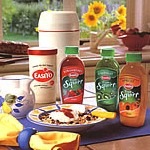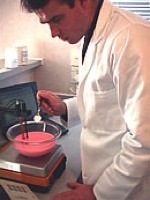Home > How We Work > EasiYo Case Study
EasiYo Case Study
Our early work with EasiYo provides a good illustration of the kind of services we provide to our clients.

EasiYo Yoghurt
EasiYo was invented by a New Zealand couple, Ken and Kathy Light about 20 years ago. Martyn worked closely with Ken and Kathy for many years, while EasiYo was still a privately owned, family business. This case study doesn't encompass every aspect of product and process development, but it serves as a good illustration of the way we work with our clients.The problem
Yoghurt is a well established food category in many parts of the world today. Typical products in this category are pre-packaged ready to serve and portion controlled in the familiar foil sealed pottles. However for those who are consumers of large amounts of yoghurt this is an expensive purchase. Additionally, because the life of probiotic bacteria in yoghurt is shorter than the shelf life of the yoghurt itself, there is no guarantee of getting the high culture counts that provide the real benefits of consuming yoghurt.The EasiYo solution
The EasiYo system allows consumers to make fresh yoghurt at home. That means consumers are guaranteed high culture counts and the benefits of fresh yoghurt. Many of EasiYo’s customers make it daily for their families. The yoghurt maker consists of an incubator partially filled with boiling water surrounding a jar containing the liquid yoghurt mix which is left to ferment for approximately eight hours, or overnight. It takes about one and a half minutes to mix the powdered yoghurt with water in the jar and to fill the incubator with boiling water. The products under development
The products under development
EasiYo wanted to develop some innovative new range-extensions, based on the dry blended yoghurt mixes that are made up with water in the yoghurt maker. These mixes had a range of fat contents and came in flavoured or unflavoured, sweetened or unsweetened varieties.
Premium high fruit content toppings were developed to supplement the yoghurt range as well as for use on ice cream. Since their primary use was for flavouring the yoghurt, consideration was needed in the balance of pH, acidity and sweetness for full flavour development while maintaining good yoghurt structure.
Confectionery style toppings were developed to supplement EasiYo’s yoghurt ice cream. These toppings were made to be chewy like a piece of toffee at ice cream serving temperature, while being thin enough to pour from the bottle at room temperature.
These two styles of topping required a different understanding and approach to their development. The fruit toppings were closer to the ripples used in the ice cream industry although they didn’t have the same stabilising system required for frozen applications. The toffee-type toppings, however, had their roots in the confectionery industry and were based on the correct sugar-glucose balance to give viscosity and prevent sugar crystallisation.
"Almost 100% of the products we sell today are ones that you have developed
|
 The development process
The development process
Although not exhaustive, here are some of the key product and process development steps that we worked through:
Idea generation
Idea generation is typically based on the existing product mix, consumer trends and changes, new ingredient innovations, existing capability, preliminary economic analysis, profit and volume expectations. Always in conjunction with marketing.
Clarifying the brief
Given the known constraints within EasiYo’s production and distribution system at the time, its markets and its product mix, many ideas and concepts were self eliminating. Those that remained were usually benchmarked against something - an existing product, a formulation, or a specific set of physical or chemical requirements.
Discovery
Before we donned our white coats and disappeared into the development laboratory, we did our homework to identify any additional constraints or road blocks to delivering on EasiYo's brief. This included identifying ingredients, packaging requirements, processing hurdles and a pre-development review of the regulatory requirements that would apply to the products in question.
Sample development
This stage, which includes formulating and testing samples in the laboratory, is by far the largest component of the development process. EasiYo had a preference for an empirical, linear approach to product development. This is an intuitive, step-wise progression, where variables are changed one at a time and the outcome assessed before moving to the next trial sample.
An alternative to this is a less intuitive, non-linear approach, where all the variables are changed at once in a factorial experimental design and the outcomes scored. The scores are then statistically analysed to produce a response surface together with an indication of ingredient interactions.
Cost and nutrition models
Primary and secondary suppliers were identified and cost models, nutrition profiles and ingredient statements developed. Cost and nutrition are easily revised and both are integral to prototype development. In some cases, such as where contract manufacturers are being used, least cost may be a driving factor.
Storage trials
Once each product or range of products had been developed, storage trials were conducted. In some cases shipping trials were also carried out.
Labelling
We then provided a label compliance service for EasiYo’s finished packaging artwork. Each new label was checked against the requirements and EasiYo was supplied with a checklist detailing any changes that needed to be made.
Process development and scale up
During prototype development in the laboratory, the manufacturing system was also developed. Although EasiYo packaged its own yoghurt mix, at that stage it used contract manufacturers for the toppings and other new products. We provided technical support to the contractors during this new product start-up phase.


